Vogtle 4 reached first criticality in February and was connected to the grid in March, following Vogtle 3 which entered commercial operation in July 2023. They are the first new nuclear units to be constructed in the USA in more than 30 years.
The construction of Vogtle units 3 and 4 was originally approved by the Georgia Public Service Commission (PSC) as part of Georgia Power's Integrated Resource Plan process in which regulators analyse and discuss the company's plans on how it will continue delivering clean, safe, reliable and affordable energy for millions of customers over a 20-year planning horizon. Construction of the two Westinghouse AP1000 reactors began in 2013.
"It's an exciting time to be a Georgian as our state continues to grow and thrive, with new demand for more clean energy each year," said Kim Greene, chairman, president and CEO of Georgia Power. "The new Vogtle units are a key piece of our strategy to meet the energy needs of our customers not only tomorrow, but 20 years from now."
The plant is operated by Southern Nuclear on behalf of co-owners Georgia Power, Oglethorpe Power, MEAG Power and Dalton Utilities. Georgia Power is a subsidiary of Southern Company.
Chris Womack, chairman, president and CEO of Southern Company, described the completion of the expansion of the Vogtle nuclear plant is a "hallmark achievement" for Southern Company, the state of Georgia and the entire USA. "Working with our partners across government, industry, labour and beyond, we have added new nuclear generation to the diverse energy resources that enhance the reliability, resiliency and affordability of our system as we work to achieve our goal to be net zero by 2050. These new Vogtle units not only will support the economy within our communities now and in the future, they demonstrate our global nuclear leadership," he said.
Plant Vogtle has provided billions of dollars of positive economic impact for Georgia and local communities, Georgia Power said. The new units have created 800 permanent jobs, in addition to over 9000 on-site jobs at the peak of construction.
Vogtle 1 and 2 have been in commercial operation since 1987 and 1989 respectively, and are currently licensed for a 60-year operating life.
State Power Investment Corporation (SPIC) said the first concrete was poured at 11.56am on 26 April. It expected to pour a total of about 6615 cubic metres of concrete over a 57-hour period.
The construction of the first two 1250 MWe CAP1000 reactors at the Lianjiang site was approved by China's State Council in September 2022. Excavation works for the units began in the same month, with the pouring of first concrete for the foundation of unit 1 completed at the end of September last year. Lianjiang unit 1 is expected to be completed and put into operation in 2028.
The CAP1000 reactor design - the Chinese version of the AP1000 - uses modular construction techniques, enabling large structural modules to be built at factories and then installed at the site.
Once all six CAP1000 units at the site are completed, the annual power generation will be about 70.2 TWh, which will reduce standard coal consumption by more than 20 million tonnes, and reduce carbon dioxide emissions by more than 52 million tonnes, sulphur dioxide by about 171,000 tonnes and nitrogen oxides by about 149,000 tonnes.
SPIC noted the Lianjiang project is the first nuclear power project it has developed and constructed in Guangdong province. It will also be the first nuclear power project in China to adopt seawater secondary circulation cooling technology, as well as the first to use a super-large cooling tower.
With a total installed nuclear power capacity of 8.09 GWe, SPIC is one of the three largest nuclear power investment, construction and operators in China. It has reactors in operation, four units under construction and a number of preliminary nuclear power project sites.
Grid challenges add to need for more nuclear, WEC side-event told
26 April 2024
Massive growth is expected in the global demand for electricity, which will require an expansion of both generation and the transmission system, speakers at a side event at the World Energy Congress 2024 agreed. Nuclear power will play an important role, they said, in ensuring the resilience of the future electricity system.
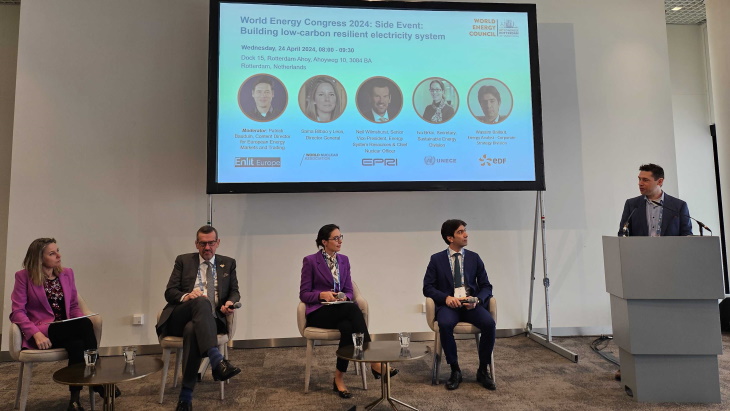 The panel (Image: WNN)
The panel (Image: WNN)The session - Building low-carbon resilient electricity system - was co-organised by World Nuclear Association, the United Nations Economic Commission for Europe (UNECE) and the Electric Power Research Institute (EPRI) on the sidelines of the World Energy Congress, held in Rotterdam, The Netherlands, on 22-25 April.
Asked about the biggest challenges to the global electricity system, World Nuclear Association Director General Sama Bilbao y León said that many developed countries have "very robust and reliable energy systems" that have been built over the years but when adding new generation - particularly intermittent renewable generation - "we have forgotten to ensure the resiliency of the system". "We are finding ourselves close to breaking point where any most-needed capacity ... is really going to require major investment into the grid itself," she said.
Neil Wilmshurst, Senior Vice President, Energy System Resilience and Chief Nuclear Operator at EPRI, said that in the developed world the challenge is integrating renewables, reliability, and resilience in the context of increasing demand. He noted that conservative estimates put future electricity demand at twice or three times the current demand. "If you look at the amount of hydrogen people say could be in demand in the US, it would take the entire current generation capacity of the US to produce it. That is the kind of magnitude of generation we're talking about. Then you throw on top of that the coming load from data centres." Meanwhile, electricity demand in developing countries is also rapidly expanding. A major challenge, he said, will be simultaneously increasing electricity supply in the developed world whilst electrifying the developing world.
Iva Brkic, Secretary of UNECE's Sustainable Energy Division, noted a recent International Energy Agency report which estimated that there was a need to add or refurbish a total of more than 80 million kilometres of grids by 2040, the equivalent of the existing global grid. "We need to double it in the next 14 years to meet our targets," she said. "So where are those resources going to come from? Where are the critical raw materials that we need to identify, to secure the supply chains, to really build that infrastructure? Now we add another layer to this - keeping the resiliency but also the reliability of that grid."
Brkic said the effects of climate change are already being experienced around the world. "How can we ensure that the system that we are now redesigning and building and modernising can withstand those impacts of climate change - the heatwaves, the droughts. This is something that we need to pay attention to.
"At the UNECE, we like to think also about the aspects of balancing between delivering on energy security, affordability and environmental sustainability. And when we think now about modernising the electricity system, it's also about balancing those aspects and creating the resiliency while actually cleaning the energy system."
The electricity sector is still one of the highest emitters of CO2, with many countries relying heavily on fossil fuels for electricity production, said Wassim Ballout, and energy analyst at EDF's Corporate Strategy Division. "One of the biggest challenges will be to satisfy this significant demand growth with decarbonised production. Not only decarbonising the existing production but also to cope with the significant increase ... the challenge would be to invest in all low-cost, low-emission technologies and to have a technological neutral approach and have good incentives to do that."
Bilbao y León said people tend to think of the energy systems of the future as being a version of what currently exists. However, she said the technology is going to be very different. "Very importantly I think that we are going to see a lot of coupling of systems … electricity is obviously going to be very important as we try to electrify a lot of energy, but clearly there are going to be additional energy vectors … all these technologies are going to make this system more complex … we can have different energy products depending on what is needed at different times to ensure the reliability and the resiliency and the flexibility of the system."
Ballout spoke about scenarios that EDF have been developing for more than 15 years, mainly for internal use. This year the company has made its scenario for net-zero publicly available. "It's fundamentally different from the other scenarios we're developing because we start with the constraints and the end. We start with net neutrality in 2050 and we go backwards. So we try to find the most economically efficient pathway to achieve this neutrality. And when I say economically efficient, I think of welfare maximisation, the minimisation of the cost and the optimisation of the resilience of the system.
"And that's how we come to a mix that shows we have to multiply by six our renewable capacity in Europe [by 2050] - we've been talking about 15 Western European countries. We will have between 120 and 150 gigawatts of nuclear capacity. We will enhance significantly the production of biofuels and CCS. We see this path will take us to a significant increase of flexibility needs … it's a very important part of the resilience of the system."
Wilmshurst said it was clear that nuclear and renewables will have a role together in the future electricity system. "If we have an idealistic view that renewables can expand and expand and expand, the transmission grid needs to expand and expand, get more complicated, and when it gets more complicated the potential for it be less reliable increases."
However, he noted that financing is a hurdle for nuclear deployment in most countries. "A great part of nuclear being perceived as expensive is the financing cost. So why is the financing cost so high? Because you have to build the nuclear plant - it takes a long time, it's complicated - but that huge capital investment upfront alone then gives you the facility that runs for many decades to recoup the investment."
"If we get deployment plans together with a clear picture ... all of a sudden, the deployment experience increases, deployment risk goes down, the confidence in the financial markets that the projects can be delivered on time increases. Finance starts flowing. If we don't make a decision to move, we don't start doing things, we don't learn as well. There's hesitancy in the markets to invest."
Ballout said nuclear and hydro play a very important role because outages of plants can be scheduled during periods where the demand is lower. "But that's why we say we have to continue financing and investing in hydro and nuclear. The nuclear fleet is capable of ramping up when suddenly you don't have sun or wind. It's possible technologically and technically speaking and at the same time it is possible to ramp down in order to leave room for renewables to produce and that's really the very important message for us."
Poland's nuclear programme making good progress, says IAEA
26 April 2024
An International Atomic Energy Agency review mission has praised steps taken to develop the necessary infrastructure for a safe and sustainable nuclear power programme in Poland. Meanwhile, Bechtel marks the start of site field work for the country's first nuclear power plant.
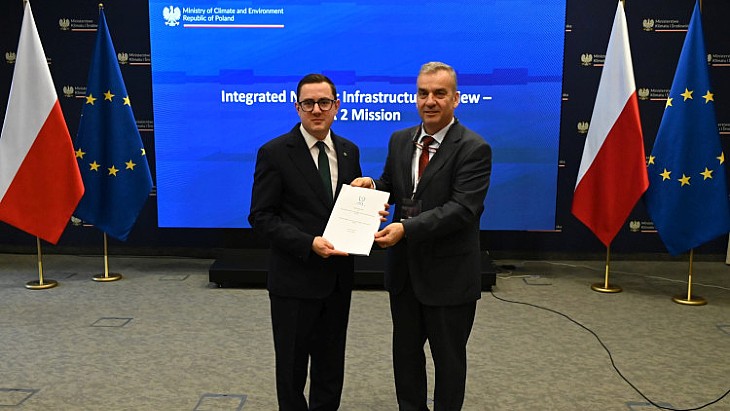 Ceyhan, right, presents the draft report to Motyka (Image: Polish Climate Ministry)
Ceyhan, right, presents the draft report to Motyka (Image: Polish Climate Ministry)
The 11-day IAEA mission to Poland - a Phase 2 Integrated Nuclear Infrastructure Review - took place from 15 to 25 April at the invitation of the Polish government and used the IAEA's Milestones Approach to review the status of 19 nuclear infrastructure issues. The aim is the check the readiness of a country to invite bids or negotiate a contract for their first nuclear power plant.
The 10-person team "identified good practices that would benefit other countries developing nuclear power in the areas of contracting approach, strategic approach to funding, early authorisation of technical support organisations to support the nuclear regulator, engagement with the electrical grid operator, stakeholder involvement and industrial involvement".
Mission team leader Mehmet Ceyhan, Technical Lead of the IAEA Nuclear Infrastructure Development Section, said: "The Polish Nuclear Power Programme (PNPP) was initiated with clear objectives and is progressing towards the construction stage in a structured way. We observed strong and dedicated teams in each of the key organisations that will help to achieve the government’s objectives for the PNPP."
Among the areas highlighted for further action was "the need to further review its legal and regulatory framework, and finalise the preparatory work required for the contracting and construction stages".
Miłosz Motyka, Undersecretary of State for the Ministry of Climate and Environment of Poland, said: "Poland's cooperation with the IAEA is a long-term collaboration, and the review mission is extremely valuable and beneficial for the implementation and execution of the Polish nuclear power programme."
The collaboration with the IAEA also involved a September 2023 Integrated Regulatory Review Service mission to the country which found Poland's nuclear regulatory framework met IAEA safety standards.
Field work getting under way
Meanwhile, a symbolic kick-off ceremony was held by US-firm Bechtel at its Warsaw office to mark the start of geological surveys for Poland's first nuclear power plant at the Lubiatowo-Kopalino site in the Pomeranian municipality of Choczewo.
Bechtel is a member of the US consortium responsible for the implementation of the nuclear power plant project which is set to feature three Westinghouse AP1000 units. The field work is due to start in May on an area covering about 30 hectares with approximately 220 research points being constructed with depths of 20 to 210 metres. Bechtel has awarded the contract for the geological work to PSD Poland, with the work expected to be completed in November.
The findings will be crucial for the earthworks design for the plant and will also inform the Location Report which Polskie Elektrownie Jądrowe (PEJ) will need to submit to obtain a construction permit from Poland's National Atomic Energy Agency, the PPA.
The event was attended by the US Ambassador to Poland Mark Brzezinski, who called it "another important step forward as Poland and the United States work together to create a civil nuclear industry in Poland, and it shows that the United States is delivering on our shared commitment to Poland’s energy security and supporting Poland’s energy transition".
Leszek Hołda, Bechtel Poland Country Manager, said: "The commencement of the initial fieldwork for the construction of this plant is a significant moment for the Polish economy, the companies that will participate in the supply chain, and the local community."
Leszek Juchniewicz, a member of the board of directors and acting president of PEJ, said this was an important time for the enterprise and showed that "the project to build Poland's first nuclear power plant is gaining momentum".
Project background
PEJ - a special-purpose vehicle 100% owned by the State Treasury - is responsible for the construction project of the first nuclear power plant in Poland.
In November 2022, the then Polish government selected the Westinghouse AP1000 reactor technology. An agreement setting a plan for the delivery of the plant was signed in May last year by Westinghouse, Bechtel and PEJ. The Ministry of Climate and Environment in July issued a decision-in-principle for PEJ to construct the plant. The aim is for Poland's first AP1000 reactor to enter commercial operation in 2033.
Under an engineering services agreement signed in September last year, in cooperation with PEJ, Westinghouse and Bechtel will finalise a site-specific design for a plant featuring three AP1000 reactors. The design/engineering documentation includes the main components of the power plant: the nuclear island, the turbine island and the associated installations and auxiliary equipment, as well as administrative buildings and infrastructure related to the safety of the facility. The contract also involves supporting t
Industria and Rolls-Royce SMR plans take step forward
26 April 2024
Poland's Industria says that it now has all the necessary ministerial opinions required to move on to the next stage of its plans for the construction of small modular reactor plants using Rolls-Royce SMR's technology.
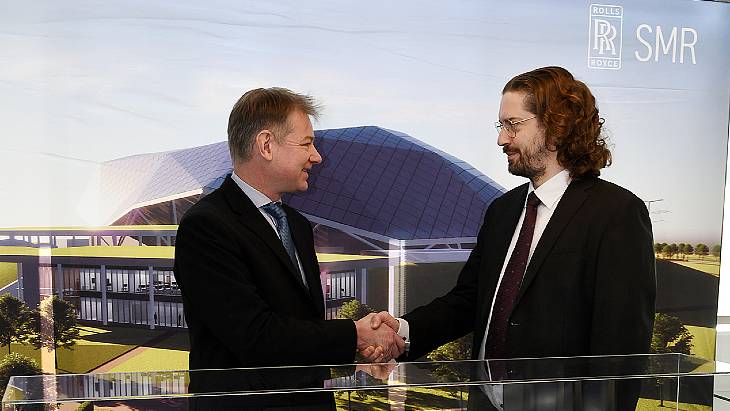 Rolls-Royce SMR’s Woods and Industria's Ruman, pictured last year (Image: Rolls-Royce SMR)
Rolls-Royce SMR’s Woods and Industria's Ruman, pictured last year (Image: Rolls-Royce SMR)The Polish Minister of Climate and Environment needed to get opinions from a range of government departments - the Minister of State Assets, the Internal Security Agency and Poland's chief Geologist - that the investment would have a "positive impact".
Now it has received all the required opinions, the ministry is able to move ahead to the next step which would be to issue a Decision In Principle to deploy Rolls-Royce SMRs, a 470 MWe design based on a small pressurised water reactor.
Last year, state-owned Industria - part of Industrial Development Agency JSC (IDA) - selected Rolls-Royce SMR technology to fulfil the zero-emission energy goals of the Central Hydrogen Cluster in Poland and as part of their plans to produce 50,000 tonnes of low-carbon hydrogen every year.
Industria submitted its application for a Decision in Principle in December to Polish Climate and Environment Minister Paulina Hennig-Kloska, and has now welcomed the receipt of the last required opinion, from Poland's Internal Security Agency.
Szczepan Ruman, President of the Management Board of Industria, said: "The positive opinion from the Internal Security Agency is a very important document for us, not only because it is the last opinion we have been waiting for and the Minister of Climate and Environment has complete documentation to decide on issuing the Decision in Principle. The positive opinion from the Internal Security Agency is important for us primarily because in this opinion, the agency - responsible for the internal security of the state, as well as for supervising the energy sector - confirms that our planned investment has a positive impact on the security of the Republic of Poland."
He added that with the Central Hydrogen Cluster he hoped "it will be possible to build a significant order portfolio from several entities for SMR units using Rolls-Royce technology, giving the Polish side a strong position in negotiations on the delivery terms of individual units, as well as, above all, in terms of the participation of the Polish industry in a supply chain for RR SMRs and thus the creation of attractive jobs in Poland."
Alan Woods, Rolls-Royce SMR’s Director of Strategy and Business Development, said: "We are delighted the Polish Government has concluded that the deployment of our unique 'factory-built' nuclear power plants would have a positive impact for the country, and we look forward to a Decision in Principle to deploy Rolls-Royce SMRs in Poland."
In July last year, Industria signed a letter of intent with the Kostrzyn-Słubicka Special Economic Zone SA (KSSSE) regarding cooperation on the location of a modular power plant based on Rolls-Royce SMR technology in the areas covered by the KSSSE.
Last month, Industria also signed a letter of intent with Chiltern Vital Group. With its partners - including Western Gateway, SGSC, University of Bristol, Vital Energi and Rolls-Royce SMR - Chiltern Vital Group intends to create a world-first net-zero and nuclear technologies campus at a site next to the former Berkeley Magnox nuclear power plant in Gloucestershire, southwest England. This will be the first step towards a 'net-zero super cluster' investment zone, encouraging the roll out of Rolls-Royce SMRs alongside an array of net-zero technologies.
The main provisions of the agreement include cooperation in: training and development of skills of Polish students and specialists; exchange of know-how to accelerate the licensing process of components dedicated to the nuclear industry; joint development of related technologies to create large low-carbon regional technology parks; and creating private financing models to ensure the viability of small modular reactor projects.he investment process and bringing it in line with current legal regulations in cooperation with the PAA and the Office of Technical Inspection.
Romanian President leads visit to Doosan SMR production facilities
25 April 2024
Romania plans a small modular reactor power plant, using NuScale technology, with South Korea's Doosan Enerbility set to manufacture and supply the core equipment, including the upper reactor module.
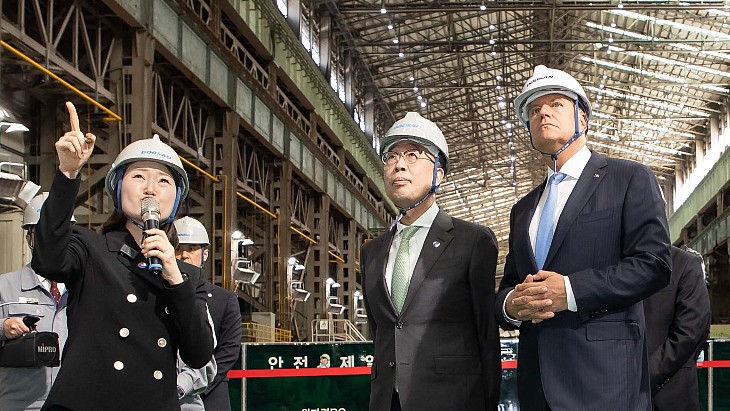 Geewon Park, centre, with President Iohannis, right, during the visit (Image: Doosan Enerbility)
Geewon Park, centre, with President Iohannis, right, during the visit (Image: Doosan Enerbility)
Romania's SMR project is aiming for 462 MWe installed capacity, using six 77 MWe NuScale modules. The SMR project, at Doicesti where a thermal power plant will be replaced, is expected to create nearly 200 permanent jobs, 1500 construction jobs and 2300 manufacturing and component assembly jobs, as well as facility operation and maintenance jobs over the 60-year life of the facility.
During the visit to the manufacturing facilities in Changwon, the delegation of senior Romanian politicians and industry figures toured the forging shop and reviewed specific facilities for SMR production and discussed the project schedule. Doosan signed a business collaboration agreement with NuScale for the supply of NuScale Power Modules and other equipment in 2019. Together with other Korean financial investors it has also made an equity investment of nearly USD104 million in NuScale Power.
President Klaus Iohannis said after the visit: "Romania wants to develop its supply chains in the clean energy industry and hence lead in supporting the regional decarbonisation efforts. International cooperation and partnering with well-established actors is key to achieving this objective and securing Romania’s energy and economic future".
Also on the visit was Cosmin Ghita, CEO of Romania's nuclear power company Nuclearelectrica, who said: "The Romanian SMR Project will benefit from the highest level of nuclear safety and technological robustness. Doosan Enerbility, with their internationally acknowledged experience in nuclear equipment manufacturing and advancements in SMR technologies, will significantly contribute to ensuring that, by the end of the 2030s, Romania will become a benchmark in advanced nuclear technology implementation and efficient long-term clean energy projects."
Melania Amuza, CEO of the SMR project company RoPower, a joint venture between Nuclearelectrica and Nova Power and Gas, said: "The sustainable development of the Doicesti SMR project includes strong supply chain links ... we look forward to building together a flagship SMR project for Romania."
Doosan Enerbility CEO and Chairman Geewon Park, said: "Leveraging a strong cooperative relationship with NuScale Power, Doosan Enerbility is consistently improving its production capabilities through innovation and technological advancements for SMRs. We are actively preparing for the deployment of Romania's first SMR project, with the goal of supporting the reliable provision of clean energy in Romania."
NuScale Power and RoPower have been conducting a Front End Engineering and Design Phase 1 study to analyse the preferred SMR site - which got International Atomic Energy Agency approval earlier this month - and received USD275 million funding last May from the USA and "multinational public-private partners" to support procurement of "long lead materials, Phase 2 Front End Engineering and Design work, provision of project management expertise, site characterisation and regulatory analyses, and the development of site-specific schedule and budget estimates for project execution".
IAEA assesses operation of Japanese reactor for 60 years
25 April 2024
Japanese utility Kansai Electric Power Company is implementing timely measures for the safe long-term operation of unit 3 at its Mihama nuclear power plant, a team of International Atomic Energy Agency experts has concluded. The team also provided recommendations and suggestions to further improve the safe operation of the unit beyond 40 years.
.jpg?ext=.jpg) The Mihama plant (Image: NRA)
The Mihama plant (Image: NRA)
Under revised regulations which came into force in July 2013, Japanese reactors have a nominal operating period of 40 years. Extensions can be granted once only and limited to a maximum of 20 years, contingent on exacting safety requirements.
In November 2016, Japan's Nuclear Regulation Authority (NRA) approved an extension to the operating period for Kansai's Mihama unit 3, a 780 MWe pressurised water reactor that entered commercial operation in 1976. The NRA's decision cleared the unit to operate until 2036. Mihama 3 was the third Japanese unit to be granted a licence extension enabling it to operate beyond 40 years under the revised regulations, following Kansai's Takahama 1 and 2 which received NRA approval in June 2016.
Mihama 3 was restarted in June 2021 after having been idle since May 2011 following the accident at the Fukushima Daiichi plant two months earlier. It became the first Japanese power reactor to operate beyond 40 years.
The International Atomic Energy Agency (IAEA) has now completed a ten-day Safety Aspects of Long-Term Operation (SALTO) mission to Mihama 3, carried out at Kansai's request.
A SALTO peer review is a comprehensive safety review addressing strategy and key elements for the safe long-term operation of nuclear power plants. SALTO missions complement IAEA Operational Safety Review Team (OSART) missions which are designed as a review of programmes and activities essential to operational safety. SALTO peer reviews can be carried out at any time during the lifetime of a nuclear power plant, although according to the IAEA the most suitable time lies within the last ten years of the plant's originally foreseen operating period. SALTO and OSART reviews are carried out at the request of the IAEA member country in which the review is to take place.
The team reviewed Mahama 3's preparedness, organisation and programmes for safe LTO. The mission was conducted by an 11-person team comprising experts from the Czech Republic, France, Sweden, the UK and the USA, as well as three observers from Finland and South Korea, and two IAEA staff members.
The team identified good performances, including that the plant has developed and effectively implemented a comprehensive methodology for identification and management of design obsolescence. The plant has also participated in benchmarking efforts related to ageing management of the steel containment and containment pressure testing and uses these benchmarking efforts to enhance the ageing management activities of the civil structures. In addition, it has put in place an effective mentoring programme using retired staff as mentors for new and current staff to develop their competencies and skills.
The team also provided recommendations and suggestions, including that the plant should further develop and implement its LTO programme and should fully develop and complete the ageing management review process for mechanical, electrical, and instrumentation and control components and civil structures. It also said the plant should improve its so-called equipment qualification programme, designed to confirm the resistance of components to harsh conditions.
"The team observed that Kansai is implementing measures for safe LTO in a timely manner and the staff at the plant are professional, open and receptive to proposals for improvement," said team leader and IAEA Nuclear Safety Officer Martin Marchena. "Some ageing management and LTO activities already meet IAEA safety standards. We encourage the plant to address the review findings and implement all remaining activities for safe LTO as planned."
The team provided a draft report to the plant management and to the NRA at the end of the mission. The plant management and the NRA will have an opportunity to make factual comments on the draft. A final report will be submitted to the plant management, the NRA and the Japanese government after comments are addressed.
"Kansai is wholly committed to improving upon the topics recommended and suggested through the SALTO review," said Kazutaka Tsuru, the general manager of the Mihama plant. "As a pioneer in Japan's nuclear power generation sector, we also intend to roll out the improvements to domestic nuclear power stations and contribute to maintaining and developing the country's nuclear power generation. Harnessing the knowledge obtained from the review, we hope to make efforts to achieve higher standards with the support of IAEA members."
Researched and written by World Nuclear News
.jpg?ext=.jpg) With all four units now in commercial operation, Vogtle is expected to produce xpected to produce more than 30 million MWh each year (Image: Georgia Power)
With all four units now in commercial operation, Vogtle is expected to produce xpected to produce more than 30 million MWh each year (Image: Georgia Power).jpg?ext=.jpg) Concrete is poured for the foundations of the nuclear island of Lianjiang 2 (Image: SPIC)
Concrete is poured for the foundations of the nuclear island of Lianjiang 2 (Image: SPIC).gif)
 The panel (Image: WNN)
The panel (Image: WNN) Ceyhan, right, presents the draft report to Motyka (Image: Polish Climate Ministry)
Ceyhan, right, presents the draft report to Motyka (Image: Polish Climate Ministry) Rolls-Royce SMR’s Woods and Industria's Ruman, pictured last year (Image: Rolls-Royce SMR)
Rolls-Royce SMR’s Woods and Industria's Ruman, pictured last year (Image: Rolls-Royce SMR) Geewon Park, centre, with President Iohannis, right, during the visit (Image: Doosan Enerbility)
Geewon Park, centre, with President Iohannis, right, during the visit (Image: Doosan Enerbility).jpg?ext=.jpg) The Mihama plant (Image: NRA)
The Mihama plant (Image: NRA).jpg?ext=.jpg) The LDR-50 reactor design (Image: Steady Energy)
The LDR-50 reactor design (Image: Steady Energy)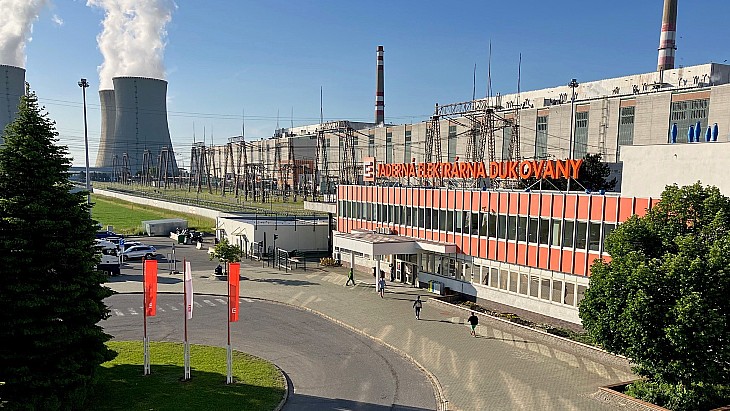 (Image: ČEZ)
(Image: ČEZ)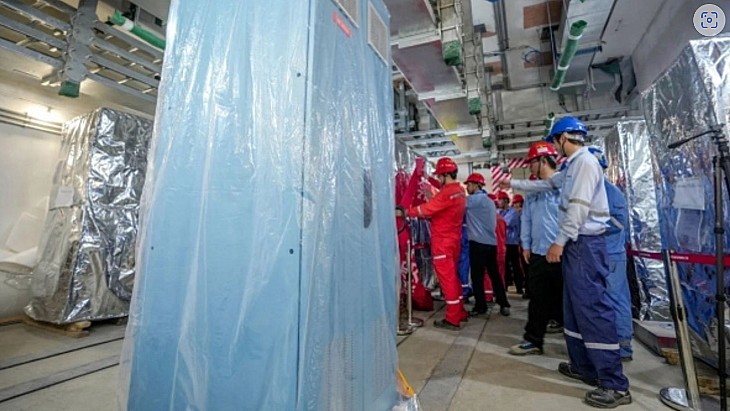 (Image: CNNC)
(Image: CNNC).jpg)
_1.jpg?ext=.jpg) Fangchenggang units 3 and 4 (Image: CGN)
Fangchenggang units 3 and 4 (Image: CGN).jpg?ext=.jpg) Workers in the control room mark the unit's attainment of first criticality (Image: CGN)
Workers in the control room mark the unit's attainment of first criticality (Image: CGN).jpg)
.jpg?ext=.jpg) Westinghouse CEO Patrick Fragman and US Ambasador Mark Brzezinski discussed the new report at a press meeting in Poland (Image: US Embassy in Warsaw)
Westinghouse CEO Patrick Fragman and US Ambasador Mark Brzezinski discussed the new report at a press meeting in Poland (Image: US Embassy in Warsaw)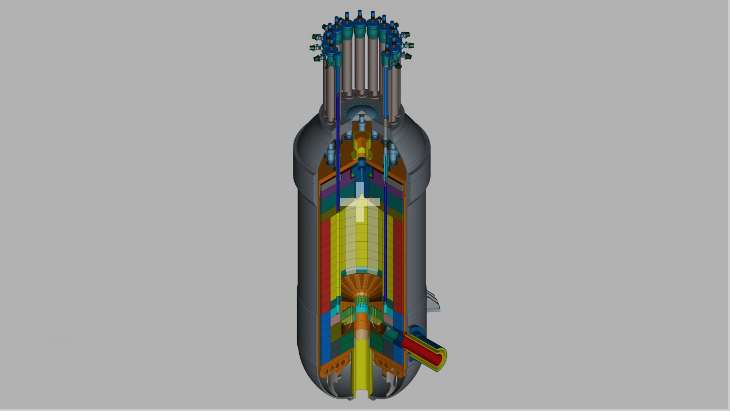 A cutaway of the reactor, much of which would be underground (Image: Stratek Global)
A cutaway of the reactor, much of which would be underground (Image: Stratek Global).jpg?ext=.jpg) How a NuScale SMR plant could look (Image: NuScale)
How a NuScale SMR plant could look (Image: NuScale)